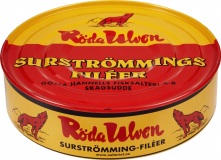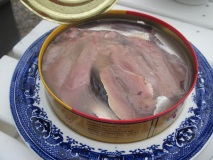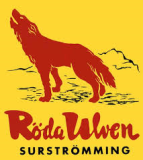- STORE
- >
- Fish & Seafood
- >
- Surströmming
- >
- Röda Ulven (Red Wolf) Surstromming Filé Traditional Swedish Fish Food 300 g ( 10.50 oz ) Made in Sweden FREE SHIPPING
Röda Ulven (Red Wolf) Surstromming Filé Traditional Swedish Fish Food 300 g ( 10.50 oz ) Made in Sweden FREE SHIPPING
SKU:
$49.99
49.99
89.99
$49.99 - $89.99
Unavailable
per item
Brand: Röda Ulven
Condition: New
Weight: 300 g ( 10.50 oz ) Net / Can
Price: $49.99 USD / Can
EAN: 7394264114003
Attention: We don't ship to Australia & USA this product only.
Condition: New
Weight: 300 g ( 10.50 oz ) Net / Can
Price: $49.99 USD / Can
EAN: 7394264114003
Attention: We don't ship to Australia & USA this product only.
Sold out
Please ask for the price. We do not ship to the US
Ingredients: Herring, water and salt.
Nutritional value per 100 g
Energy (kcal) 93 kcal, Energy (kJ) 389 kJ, Fat 4.50 g, Of which saturated fat 1.10 g, Carbohydrates 0.73 g, Of which sugar 0.73 g, Protein 12.60 g, Salt 7 g
Ingredienser: Strömming, vatten och salt.
Näringsvärde per 100 g
Energi (kcal) 93 kcal, Energi (kJ) 389 kJ, Fett 4.50 g, Varav mättat fett 1.10 g, Kolhydrater 0.73 g, Varav socker 0.73 g, Protein 12.60 g, Salt 7 g
How do you eat fermented herring?
Surströmming eat together with unleavened bread and potatoes, preferably fresh potatoes. This is like the very foundation. As examples of accessories include raw onions and tomatoes. The imagination is the only limit. Flatbread Mackan be eaten with "cap", two slices with butter between. Some people prefer to make a Surströmmings Clip where fermented herring, potatoes, onions and tomato wrapped in soft flatbread. When it comes to traditional fermented herring swallowed should of course flatbread be hard.
What do you drink then?
'Yes, it directly think of is beer but some actually prefer milk. The disadvantage of milk may be that it is then cut themselves with snaps. Schnapps is no need of it is alleged that the party is even more fun then.
History of Surstromming
"Soured fishing is an ancient dish whose preparation nature herself always taken care of right from the creation of the world. Our parents sniffed it already outside the gates of Paradise, and it was early known well at all kjökkenmöddingar and pålhyddor, as with the Greeks and Romans, for they all knew what pickled fish meant; but the taste derfor was not yet as mature as now - they knew not then haut goût. "
Dr.CH P.M. Hagdahl in the late 1800s.
Prehistoric perspective.
Along with drying and salting is the method of preserving food by acidification (fermentation, fermentation) as old as mankind. If only it set down has happened so nothing has happened in human perspective.
I would still like to mention some recorded documents dated before any salt deficiencies and battles.
In an official document from Jämtland (when Norwegian) dated 1348 said that Olafuer Graflaks exchanged the fishing rights. Names suggest, according to the custom, he was dealing with marinated salmon, which at the time was steeped salmon by burial.
From Babyulonium are stone tablets dated 2800 BC with recipes for acidification (fermentation) of various products.
Production Tops.
Countless myths and urban legends are about surströmmingens emergence.
These have arisen only by sharp increases in production depends on economic and political reasons. Eg salt shortage periodically during 1500 and 1700 -talen, the large field teams during the 1700s, the Swedish Consumer breakthrough in the early 1900s, and others.
None of these 'production peaks' and its causes are surströmmingens birth. Sour herring has always been there herring and humans existed. As well as all other fish fermented where they existed and / or available (roach, carp, plara, salmon, trout, Bori, sharks, rays, flying fish, etc ...)
Some methods and phenomena.
The methods vary due to geographical and cultural differences.
Similarities are nature's role in the various processes and parameters; Ingredient, salt, temperature, acid.
Where salt was expensive or in short supply has yet acidification could develop due to low temperatures. The peoples of northern Russia and Siberia leavens salmon by packing fresh fish directly into pits or in wooden vessels that are dug into the ground. You salts either light or none at all. The fish are packed by stepping on it. After 8-10 months in the fish up and has since gained a batter or jelly-like consistency. It is eaten either with a spoon soup or baked into bread. What makes this approach possible is permafrost, which keeps the temperature constant below 4 ° C.
Another example is Rakfisk production in Norway.
Rakfiskbältet stretches from the Northeast Jämtland, Härjedalen through Røros and further south through Valdres, "Norway's Rakfiskcentrum" to Setesdal.
For example, Valdres is the farms that traditionally produced Rakfisk about the middle of the mountain sides. Further out towards the coast, near the warm Gulf Stream, lies the farms higher up. Farms location ensures a low, uniform temperature. Rakfisk sometimes leavened with weak brine, 3.5- 4.5%, the temperature of 1-3 ° C and the fermentation time of 12 - 14 months. Another measure is 6%, 6 ° C and 6 weeks.
Everything is linked.
This knowledge has its origins far back in time
Surströmming. No exception.
Previously, there was only the need to preserve periodically abundant catches of herring so long, and at such low cost, as possible. They then used a little salt, fermented during low temperature and for a long time, about 8-12 months. A anna important factor was that acidification was not allowed to be too hasty to surströmming was for dandruff. The risk was then that it shook apart during the often violent and primitive shipments.
During the 1400s and well into the 1500s in northern Pisces and later the so-called Gävle fishermen who negotiated for himself fish right along the northern coast, was the production of salt herring dominant. This production was an important source of income for Sweden. Every 10 thin paid to the State for lease. Salt Herring was sold to various countries in Europe right down around the Mediterranean.
Gustav Vasa used these revenues to finance wars and reforms.
Salt Lack 1520 - 1530
Gustav Vasa had neglected their credit in Lubeck are punishing Sweden by strangling salt deliveries to Sweden. The salt was scarce and the price skyrocketed. Surströmming produced in the past but now increased the production of very understandable reasons.
Salt Lack 1716-1720
Sweden had a big fight with England which resulted in sanctions and complicated deliveries. This created a salt shortage and prices skyrocketed. Of course tailored to the people of the situation.
The production of fermented herring increased and salt herring declined.
The large field teams
Research on this part of the description of past events going on !.
With the large field teams during the 1600- 1700's, the situation changed. The view of acidified food was altered. The fact that different products were long-lasting acidification knew. The content of nutrients and its effect on the body was a new insight.
Partly had scurvy, on the great sailing ships, virtually disappeared because of sauerkraut and other fermented products. And both had the devastating Russian raids in different parts of Europe, Russia and along the Swedish coast of Norrland given an entirely new war strategy skills. The Russians were very efficient and seemingly tireless!
King Karl X Gustav 1654 - 1660 warfare developed into an art form. He learned from studies of various wars and famous commander.
Food and water were the major field Act's biggest problems. A large army could be 10,000 to 40,000 man + tens of thousands of horses. Added to this is those who always followed and the armies tow. At most, it could be 4 people per soldier. It was; Court Administration, the officer families, butlers, baggage, whores, artisans, adventurer, mm, mm. Looting was the main job and the fact that an army is not in constant motion, was almost doomed meant that food, water and hygiene were major problems. Scurvy-ridden and could turn victory into defeat.
Then it was surprising that some armies could run unabated.
Ingredients: Herring, water and salt.
Nutritional value per 100 g
Energy (kcal) 93 kcal, Energy (kJ) 389 kJ, Fat 4.50 g, Of which saturated fat 1.10 g, Carbohydrates 0.73 g, Of which sugar 0.73 g, Protein 12.60 g, Salt 7 g
Ingredienser: Strömming, vatten och salt.
Näringsvärde per 100 g
Energi (kcal) 93 kcal, Energi (kJ) 389 kJ, Fett 4.50 g, Varav mättat fett 1.10 g, Kolhydrater 0.73 g, Varav socker 0.73 g, Protein 12.60 g, Salt 7 g
How do you eat fermented herring?
Surströmming eat together with unleavened bread and potatoes, preferably fresh potatoes. This is like the very foundation. As examples of accessories include raw onions and tomatoes. The imagination is the only limit. Flatbread Mackan be eaten with "cap", two slices with butter between. Some people prefer to make a Surströmmings Clip where fermented herring, potatoes, onions and tomato wrapped in soft flatbread. When it comes to traditional fermented herring swallowed should of course flatbread be hard.
What do you drink then?
'Yes, it directly think of is beer but some actually prefer milk. The disadvantage of milk may be that it is then cut themselves with snaps. Schnapps is no need of it is alleged that the party is even more fun then.
History of Surstromming
"Soured fishing is an ancient dish whose preparation nature herself always taken care of right from the creation of the world. Our parents sniffed it already outside the gates of Paradise, and it was early known well at all kjökkenmöddingar and pålhyddor, as with the Greeks and Romans, for they all knew what pickled fish meant; but the taste derfor was not yet as mature as now - they knew not then haut goût. "
Dr.CH P.M. Hagdahl in the late 1800s.
Prehistoric perspective.
Along with drying and salting is the method of preserving food by acidification (fermentation, fermentation) as old as mankind. If only it set down has happened so nothing has happened in human perspective.
I would still like to mention some recorded documents dated before any salt deficiencies and battles.
In an official document from Jämtland (when Norwegian) dated 1348 said that Olafuer Graflaks exchanged the fishing rights. Names suggest, according to the custom, he was dealing with marinated salmon, which at the time was steeped salmon by burial.
From Babyulonium are stone tablets dated 2800 BC with recipes for acidification (fermentation) of various products.
Production Tops.
Countless myths and urban legends are about surströmmingens emergence.
These have arisen only by sharp increases in production depends on economic and political reasons. Eg salt shortage periodically during 1500 and 1700 -talen, the large field teams during the 1700s, the Swedish Consumer breakthrough in the early 1900s, and others.
None of these 'production peaks' and its causes are surströmmingens birth. Sour herring has always been there herring and humans existed. As well as all other fish fermented where they existed and / or available (roach, carp, plara, salmon, trout, Bori, sharks, rays, flying fish, etc ...)
Some methods and phenomena.
The methods vary due to geographical and cultural differences.
Similarities are nature's role in the various processes and parameters; Ingredient, salt, temperature, acid.
Where salt was expensive or in short supply has yet acidification could develop due to low temperatures. The peoples of northern Russia and Siberia leavens salmon by packing fresh fish directly into pits or in wooden vessels that are dug into the ground. You salts either light or none at all. The fish are packed by stepping on it. After 8-10 months in the fish up and has since gained a batter or jelly-like consistency. It is eaten either with a spoon soup or baked into bread. What makes this approach possible is permafrost, which keeps the temperature constant below 4 ° C.
Another example is Rakfisk production in Norway.
Rakfiskbältet stretches from the Northeast Jämtland, Härjedalen through Røros and further south through Valdres, "Norway's Rakfiskcentrum" to Setesdal.
For example, Valdres is the farms that traditionally produced Rakfisk about the middle of the mountain sides. Further out towards the coast, near the warm Gulf Stream, lies the farms higher up. Farms location ensures a low, uniform temperature. Rakfisk sometimes leavened with weak brine, 3.5- 4.5%, the temperature of 1-3 ° C and the fermentation time of 12 - 14 months. Another measure is 6%, 6 ° C and 6 weeks.
Everything is linked.
This knowledge has its origins far back in time
Surströmming. No exception.
Previously, there was only the need to preserve periodically abundant catches of herring so long, and at such low cost, as possible. They then used a little salt, fermented during low temperature and for a long time, about 8-12 months. A anna important factor was that acidification was not allowed to be too hasty to surströmming was for dandruff. The risk was then that it shook apart during the often violent and primitive shipments.
During the 1400s and well into the 1500s in northern Pisces and later the so-called Gävle fishermen who negotiated for himself fish right along the northern coast, was the production of salt herring dominant. This production was an important source of income for Sweden. Every 10 thin paid to the State for lease. Salt Herring was sold to various countries in Europe right down around the Mediterranean.
Gustav Vasa used these revenues to finance wars and reforms.
Salt Lack 1520 - 1530
Gustav Vasa had neglected their credit in Lubeck are punishing Sweden by strangling salt deliveries to Sweden. The salt was scarce and the price skyrocketed. Surströmming produced in the past but now increased the production of very understandable reasons.
Salt Lack 1716-1720
Sweden had a big fight with England which resulted in sanctions and complicated deliveries. This created a salt shortage and prices skyrocketed. Of course tailored to the people of the situation.
The production of fermented herring increased and salt herring declined.
The large field teams
Research on this part of the description of past events going on !.
With the large field teams during the 1600- 1700's, the situation changed. The view of acidified food was altered. The fact that different products were long-lasting acidification knew. The content of nutrients and its effect on the body was a new insight.
Partly had scurvy, on the great sailing ships, virtually disappeared because of sauerkraut and other fermented products. And both had the devastating Russian raids in different parts of Europe, Russia and along the Swedish coast of Norrland given an entirely new war strategy skills. The Russians were very efficient and seemingly tireless!
King Karl X Gustav 1654 - 1660 warfare developed into an art form. He learned from studies of various wars and famous commander.
Food and water were the major field Act's biggest problems. A large army could be 10,000 to 40,000 man + tens of thousands of horses. Added to this is those who always followed and the armies tow. At most, it could be 4 people per soldier. It was; Court Administration, the officer families, butlers, baggage, whores, artisans, adventurer, mm, mm. Looting was the main job and the fact that an army is not in constant motion, was almost doomed meant that food, water and hygiene were major problems. Scurvy-ridden and could turn victory into defeat.
Then it was surprising that some armies could run unabated.





